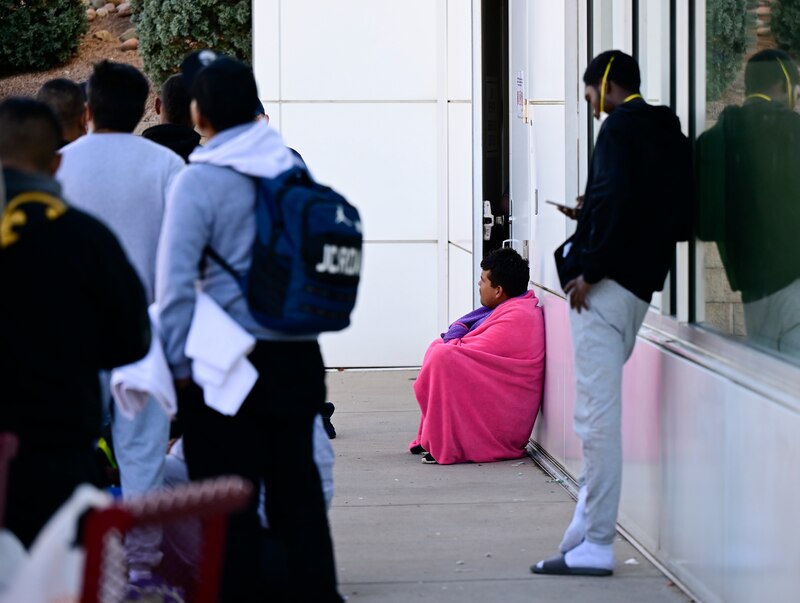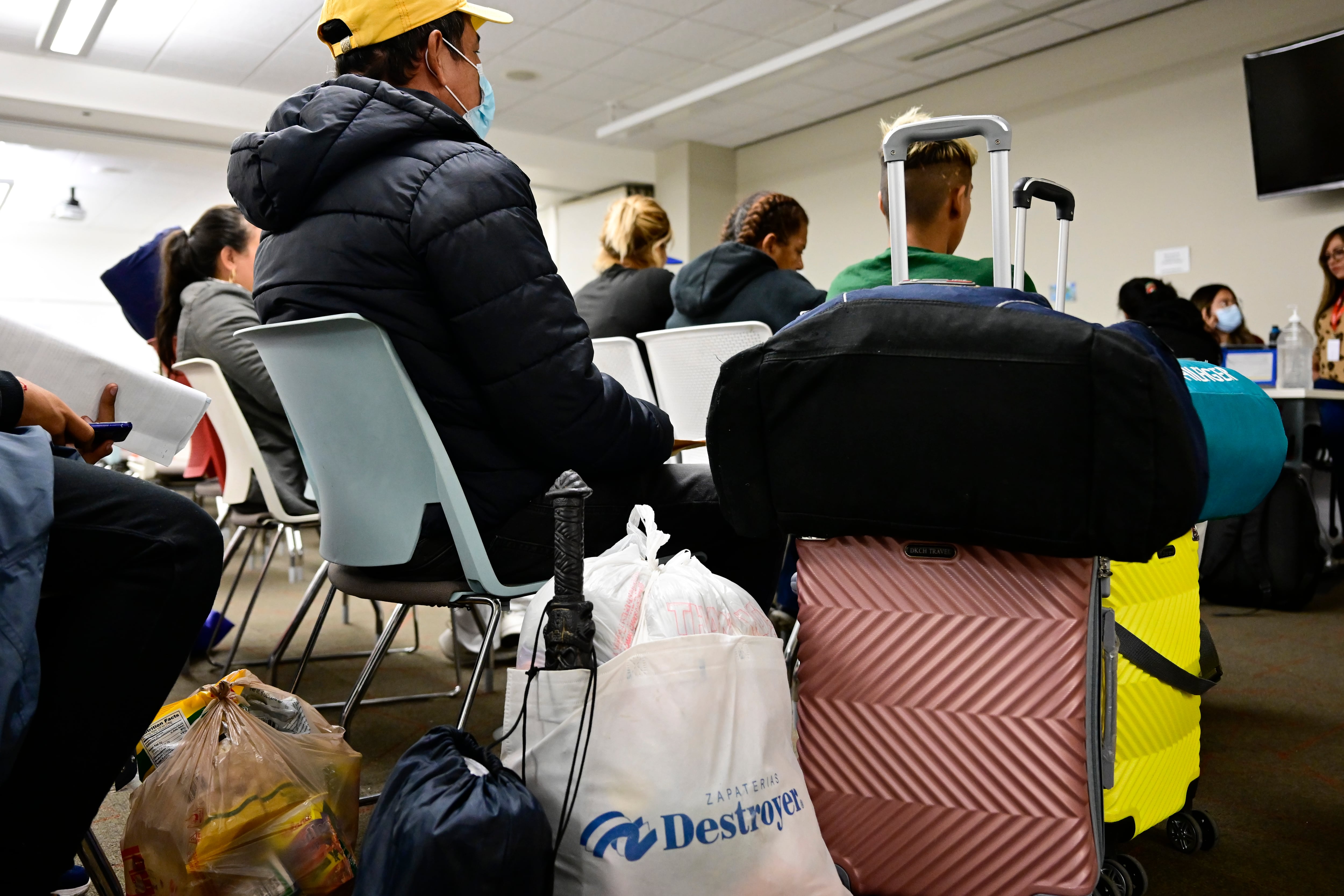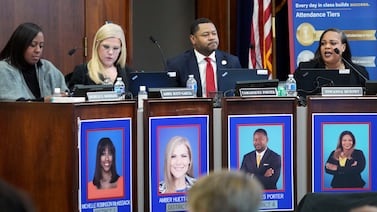Sign up for Chalkbeat Colorado’s free daily newsletter to keep up with education news in Denver and around the state.
Editor’s note: On Monday, Denver Human Services extended the time that families can stay in city-provided shelter to 37 days, a week longer than previously. The change applies to people who arrive on or after Oct. 4. However, due to the large number of people arriving daily, individuals without children will get to stay in city-provided shelter for just 14 days, a week less than before.
As the number of migrants arriving daily in Denver rises, schools are starting to see a significant number of new students. And educators are worried about how to help them as migrant families encounter the limits of official support.
At Denver’s Bryant Webster Dual Language School, some teachers report classes of 38 students — a lot higher than last year. A teacher who screens students for whom English is not their home language has had to screen 60 students this year — up from a handful in typical years. And they’re trying to help students as they’re dealing with trauma, learning how to navigate a new country and a new school system.
“You work the whole day and you just want to make sure you do the best with the resources you have and so you build relationships with kids, and you have the connection to them,” said Alex Nelson, a fourth grade teacher at Bryant Webster. “Then you find out their story.”
Students who arrived near the start of the school year and were starting to settle in are facing a new challenge and a new trauma. Families get just 30 days in either a hotel or shelter paid for by the city. But then they have to find another place to live. In a city with soaring rents where many longtime residents also struggle to find housing, new arrivals sometimes find themselves with nowhere to go.
The first time a migrant family with children at Bryant Webster ran out of time on its housing voucher, teachers and a school intern spent hours calling shelters and everyone they could think of to try to find a place for the family to stay. They encountered waitlists and a lot of dead ends.
“We didn’t know what happened after the voucher expired until one of the new families said ‘our stay is up, and we don’t know where to go tonight,’” Nelson said. “We’ve never been prepared so we didn’t know how to handle it.”
The family ended up leaving to spend the night in a car, though Nelson said district officials were able to connect with them later that evening. Still, Nelson said it was really hard on the entire school to end the day that way.
Like in New York City schools and other districts nationwide, Denver school officials are on the frontline receiving requests from migrant families for help. In Denver, some teachers are just starting to connect their efforts with nonprofits, through the teachers union, and with other organizations, but coordination is still sporadic.
And even when working together, there are daunting obstacles. After the limited duration of city vouchers for migrants, the different social services available have different rules that can create confusion about what might jeopardize migrants’ legal standing. And the potential overlap between help for migrants and support for the city’s homeless population is something Denver officials are trying to avoid.
After helping the first Bryant Webster family, teachers heard from more families in the same situation. Some organizations are helping, but each time a new family comes forward, teachers worry if they’ll be able to find them assistance. At least three more are slated to lose their shelter this weekend.
“You can just feel the kids are stressed. It disrupts everything,” said Cecilia Quintanilla, an early childhood teacher at the school.

Schools join Denver effort to help migrants find stability
Right now, it’s hard to track how widespread the surge of migrants in schools really is.
District officials in Denver did not respond to requests for comment. Teachers at Bryant Webster believe they’ve had around 60 newcomers arrive after the first day of school and counting. Other school districts in the state are also reporting surges of newcomers, the term schools use to refer to students arriving from outside the U.S., in the last few months.
The Colorado Department of Education doesn’t track those numbers and officials said they have not been asked to provide support to schools dealing with these surges.
Denver officials said that as of last week the city was currently sheltering 456 children under age 16. The city has seen up to 250 new individuals arriving per day this week, but numbers for children aren’t available for this week.
At another Denver school, Escuela Valdez, teacher Jessica Dominguez estimates they’ve received about 20 newcomer students this year. This week, they learned about a family that had already been sleeping outdoors after losing their shelter. Educators stayed up late into the night trying to find them a place to stay and ultimately were successful. But that may not always be the case.
“Kids are being involved now,” she said. “That puts a different face to what we might think is homelessness.”
Dominguez isn’t the only person who feels that way. Denver Mayor Mike Johnston, a former educator, said at a press conference Thursday that he has seen kids sleeping under blankets with families outside the city’s Wellington Webb building as they wait for staff to show up so they can ask for help.
“No kid should be in that context,” Johnston said.
Early that same day, at a migrant reception center in northeast Denver, a steady stream of men, women, and children arrived for processing. The official hours are 8 a.m. to 5 p.m., but staff often start earlier and stay until everyone has somewhere to go.
Some arrivals have family in the Denver area and ask to come here or even make their own way. Others get on buses in El Paso regardless of destination and then need to make a plan.
They’ve already made a hazardous journey and overcome many obstacles to leave behind dangerous situations in their home countries.
Jon Ewing, a spokesman for Denver Human Services, said the arrivals are smart, resourceful, and well-organized.
City workers collect basic information about the new arrivals, provide contact information for relevant social services and direct them to shelter. Individuals are eligible for 21 days of free shelter and families are eligible for 30 days. The city isn’t tracking what happens after that.
“Thirty days is not a long time to sort out your life, and we get that,” Ewing said. “But we have to move people through. There is a limit to what we are able to do.”
Ewing said city staff are working to coordinate as best they can between nonprofits, city services, and the school district — there are large group chats buzzing all day.
Ewing said the city tries to make sure people understand how expensive Denver is so they can make informed decisions. But they may have good reasons for wanting to stay here.
Ewing said the migrant and homeless populations are very different and face different challenges. New arrivals are never directed to homeless shelters, and many services are provided through different channels in order to be responsive to each group’s needs.
There are also different funding sources with different rules, when it comes to providing services for U.S. citizens and residents experiencing homelessness, versus migrants seeking asylum or another protected status.
Then there are legal concerns. Cathy Alderman, chief communications and public policy officer for the Colorado Coalition for the Homeless, said that organizations like hers are also concerned about inadvertently providing resources that would then make people ineligible for earning legal status — a common worry they hear from migrants, and one that Alderman and her team don’t have enough expertise to help navigate.
Still, she said that some of the migrant families might qualify for housing assistance from the coalition, but qualifying takes time.
“The problem is we have so many in the system right now waiting for housing,” Alderman said. “That system makes housing matches based on vulnerabilities. It’s a process. It certainly doesn’t move fast.”
She said that another problem for families is finding affordable housing with multiple bedrooms. Longer term vouchers, such as Section 8 vouchers, often don’t cover a large portion of the rents people might encounter in Denver.
“In Denver specifically we have a very, very, very minimal stock of really affordable housing,” she said. “We have a lot of market rate and luxury units that are sitting empty.”
With all the challenges migrant students and their families are confronting, teachers say they appreciate that so many are working to help. But they also wish they were more prepared to help students and families who come to them with such big worries.
“We don’t have what we need to welcome these families to the better life that they were searching for,” said Nelson, the teacher at Bryant Webster. “It’s just really hard to see the consequences of that.”
Yesenia Robles is a reporter for Chalkbeat Colorado covering K-12 school districts and multilingual education. Contact Yesenia at yrobles@chalkbeat.org.
Bureau Chief Erica Meltzer covers education policy and politics and oversees Chalkbeat Colorado’s education coverage. Contact Erica at emeltzer@chalkbeat.org.







